Abstract
This work calculates and discusses the Life Cycle Assessment (LCA) of four scenarios composed of two types of road pavements and two types of lighting systems to be built in an Italian twin-tube road tunnel. A 20-year time horizon is adopted to assess the burdens of construction and maintenance of both flexible and rigid pavements and high-pressure sodium (HPS) and light-emitting diode (LED) lamps, traffic, and switching on of lamps. All considered scenarios are comparable with each other in terms of technical performances, but significantly differ regarding their environmental consequences. The geometrical and technical characteristics of the examined scenarios comply with current Italian standards for highways. In all the examined cases, LCA is carried out according to the European standard, EN 15804, and includes 19 impact categories (IC). The analysis demonstrates that the use of more reflecting surface pavement materials (i.e., concrete vs. asphalt) and more performing lighting systems (i.e., LED vs. HPS) can effectively mitigate the deleterious burdens related to road construction, maintenance, and use. For most of the examined ICs, the most environment-friendly scenario has LED lamps and concrete pavement.
1. Introduction
The energy efficiency of public lighting installations has become an important area of focus in the last years [1]. Public administrations and lighting designers are making efforts to design and adopt the best solutions to produce an efficient luminance and save energy [2]. In road infrastructures, tunnels are the most energy demanding of the whole asset because of the need of the prescribed equipment in tunnels. Indeed, it is necessary to provide adequate lighting, signing, and ventilation for drivers; to maintain drainage systems; and to deal with emergencies. The largest energy requirements are associated with providing lighting. Lighting costs represent up to 25% of the total budget for management of the road network [3,4].
The European Community has provided calls for research projects to enhance the energy efficiency of road tunnel operation through the promotion and implementation of appropriate technologies [5]. Among them, the REETS project (Realistic Energy Efficient Tunnel Solutions) deals with the enhancement of the energy efficiency of road tunnels using appropriate technologies [6].
Many technologies could improve operational energy efficiency in road tunnels [7,8,9]. Regarding the lighting system, the main measures pertain the use of efficient lamps. This is growing the interest towards the technological evolution of the lamps. Since the 1970s, gas-discharge lamps, sodium lamps, and high-pressure sodium lamps (HPS) have been passed on until the introduction in 2000s of light-emitting diode lamps (LED). LED lighting systems, especially if solar powered [10], can improve the efficiency of lighting systems during their service life. However, LEDs are not globally used for road lighting systems. Indeed, HPS lamps are currently one of the most used types of light source and the road lighting upgrade is still in progress [11].
Many other complementary measures could contribute to operational energy efficiency in road tunnels. The most effective ones concern the tunnel lining and the road surface materials. Indeed, self-cleaning lining panels can produce 2.5% energy savings [12], while the use of a white and highly-reflective road surface materials can improve the driver visibility, and save more than 20% due to less luminaires required [10].
Design options of a road infrastructure determine its sustainability and efficiency during the whole life cycle. For road tunnels and similar underground structures, in particular, there are both technical and economic constraints and opportunities to be considered [13,14]. In fact, these infrastructures require special attention due to their technical characteristics and performances that they must ensure, especially regarding the safety and comfort of users [15]. A road tunnel, in fact, is a complex infrastructure where a sensitive equilibrium is needed between the civil structures and the technical systems; among these components, an important role is played by the road pavement and the lighting system [16]. They determine the safety condition experimented by users, in terms of friction, stability, evenness, and visibility along the road section. At the same time, they significantly influence the economic, environmental, and energetic sustainability of the tunnel [17]. Recent research has highlighted that the use of lighter surfaced pavements can be a valid design solution to reduce lighting consumption. For this purpose, more reflective asphalt mixes [18] and concrete pavements [19] have been studied. Particularly, in the past, the use of concrete has been encouraged as an alternative to the commonly adopted asphalt mixes because of its long service life and durability without needing onerous maintenance works [20]. Another huge benefit to using concrete pavements in tunnels regards the road safety as the reduced maintenance works required by this type of pavement decreases the reduction of a lane change and therefore reduces the likelihood of accidents related to maintenance phases [21]. In addition, concrete is an incombustible material and non-toxic in the case of fire in the tunnel [22]. However, this material offers other advantages if used in tunnels: Compared to asphalt, it allows a reduction of energy needed to provide the required luminance. The reduction of the electrical energy consumption (up to 30% less both in the installation and the management cost of the plant) [23] implies a reduction of emissions into the environment, as confirmed by recent Life Cycle Assessment (LCA) studies [24].
Energy saving is challenging, especially in Italy, where many tunnels are widespread over the whole territory. Italy has the highest number (greater than 600) of tunnels of the Trans-European Road Network (TERN) [25], having more than half of the total assets in Europe.
In the last years, in Italy, the increasing attention to energy-saving led to the use of the most performing lamps [18] and studying the impact of reflective road pavements on lighting consumption. Road agencies are substituting old and inefficient lighting HPS systems with more recent and better performing LED ones, and, in the last five years, about 50 km of new and rehabilitated tunnels were built with concrete pavements. However, the process is slow and expensive: The high installation cost of LED lamps discourages road agencies from substituting HPS lamps [18], and the vast majority of tunnels still have HPS lamps.
This paper presents the environmental performances of two types of road pavements (i.e., flexible and rigid pavement) and two types of lighting systems (i.e., HPS and LED lamps) to be built in a 750 m-long twin-tube tunnel, which belongs to an Italian highway. The study has been conducted according to the Italian standards about the design of road pavements [26] and tunnel lighting [27,28,29], and European methods about environmental [30] and human health impact indicators [31,32]. The proposed study consisted in quantifying and discussing 19 indicators related to four “from cradle to gate with option” boundary systems (i.e., including production and construction processes, maintenance of the lighting system and road pavement, and vehicular passes). The interpretation of the LCA results of the environmental and human health impacts is useful to understand and improve processes and technologies currently used in the road section to reduce its environmental burdens.
2. Materials and Methods
In this study, the LCA methodology was used to assess the life cycle impacts of pavement and lighting in a twin-tube road tunnel whose cross-section is 9.5 m wide, and is composed of two 3.50 m-wide lanes and two 1.25 m-wide shoulders. In the examined case study, the subgrade resilient modulus is equal to 90 MPa, and the design traffic complies with data listed in Table 1 [33].

Table 1.
Design traffic.
According to the Italian Catalogue of road pavements [26], these numbers of passes of commercial and heavy vehicles determine the following pavement compositions, from top to down: For flexible pavement: 4 cm-thick wearing layer, 5 cm-thick binder layer, 12 cm-thick asphalt base layer, and 15 cm-thick granular subbase; and for concrete pavement: 18 cm-thick jointed plain concrete slab, 15 cm-thick cement bound base, and 15 cm-thick unbound granular subbase.
Routine maintenance for the examined pavements complies with routine programs listed in [19]: For rigid pavement, joint sealing and grinding are scheduled; and for flexible pavement, milling, patching, and re-construction of wearing, binder, and base are programmed.
Regarding the lighting system, the average characteristics of the considered HPS and LED lamps are shown in Table 2.

Table 2.
Average characteristics of considered lamps.
The lighting systems were designed according to the requirements laid down by the Italian Organization for Standardization (UNI) for road lighting [27,28,29]. Particularly, the standard UNI 11095 [29] divides the longitudinal section of the tunnel into five reference zones (i.e., access, threshold, transition, interior, and exit zones) (Figure 1).
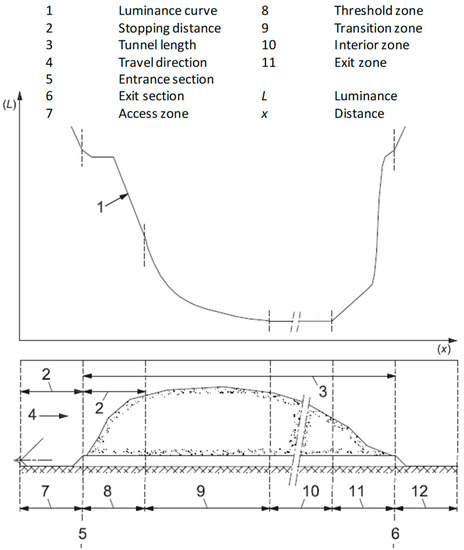
Figure 1.
Reference zones for the tunnel lighting system.
Each zone differs for the minimum luminance value to be ensured as a consequence of the design speed, the meteorological visibility distance, the horizontal lighting in the access zone, the natural luminance, and the optics type Equations (1)–(3).
where Le is the maximum luminance value of Lv; c is a coefficient, which depends on the optics; Lv is the veiling luminance; Lseq is the equivalent veiling luminance; Latm is the atmospheric luminance; Lpar is the luminance of the windshield; Lt is the average luminance value in the transition zone; Lcru is the luminance of the dashboard; t is the travel time in the transition zone; Li is the minimum luminance of the permanent lighting circuit; and Lr is the reference luminance value according to [28].
Le = c × Lv = c (Lseq + Latm + Lpar + Lcru)
Lt = Le/(1.9 + t)1.4
Lt ≥ 2 × Lr
Figure 2 shows the luminance curve obtained for the examined 750 m-long tunnel.
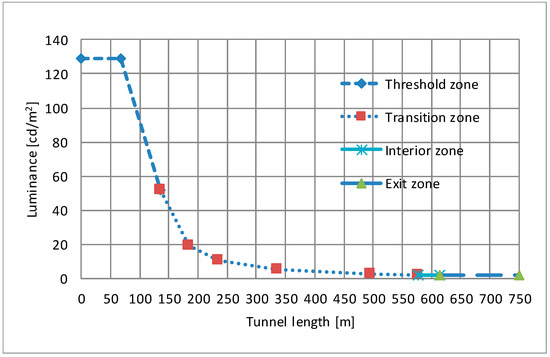
Figure 2.
Luminance curve.
The average luminance coefficient (Q0) of the examined pavement types significantly differs. It represents the brightness of the surface and plays a fundamental role in the design of road lighting. For concrete, Q0 is 0.1, while for asphalt it is 0.07 [27]. Figure 3 shows the required illuminance on the road surface that produces the prescribed luminance level for different pavement types (and Q0).
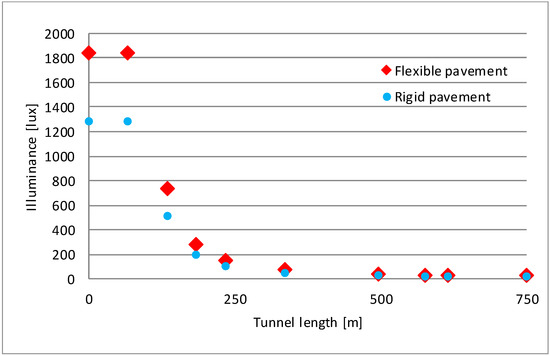
Figure 3.
Illuminance curves.
Therefore, the rigid pavement needs lower illuminance than the flexible pavement to ensure equal luminance values. This difference decisively affects the lighting design, which has been verified using the software package, ProLITE7.0® [34], under the following hypotheses:
- Maintenance factor (i.e., the ratio between the average luminance in service and the average luminance obtained with a new installation) is equal to 0.9 (according to [29]).
- Average wall diffuse reflection factor is equal to 0.5.
A permanent lighting circuit and a reinforcement lighting circuit compose the lighting systems to obtain the luminance curve in Figure 2. The lamps are arranged in a single line in the permanent lighting, and in a quincunx geometric pattern in the reinforcement systems.
The lighting systems have been designed for the daytime of sunny days, which represent the most severe condition during the year. However, the used power depends on the external luminance (Equation 1); therefore, visual comfort goals and energy saving requirements are needed for using variable lighting power during a solar year (e.g., sunny days are 34% of the overall yearly days and require 100% of the installed power). Table 3 lists the values of the overall installed power, and the yearly consumption of the designed lighting systems. The lighting design pursued the aims of both guaranteeing the minimum luminance values according to [29] and minimizing the installed power.

Table 3.
Data about the designed lighting systems.
Routine maintenance for the designed lighting systems provides that every 2.5 years, the lamps are cleaned, and they are substituted at the end of their service life (Table 2).
The approach for assessing the life cycle impacts of road materials and construction complies with that proposed in the literature for asphalt mixes [35], road construction [36], and the average grey Italian Cement [37]. Input data for the Life Cycle Inventory (LCI) of HPS and LED lamps derive from the comparison of LED and HPS technologies carried out by [38].
The LCA has been carried out according to the European standard, EN 15804 [30], the methodology ECO-Indicator 99 (E) V2.08 for assessing the Land use [31], the methodology CML 2 BASELINE 2000 V2.05 for assessing Human Toxicity Potential [32,39], and the methodology ECO-Indicator 99 (E) V2.09 for assessing Ecotoxicity [31].
Data collected in the LCI were modelled using the characterization factors defined by the above-mentioned model. The concept of characterization factors permits comparison of the ability of different chemical compounds to cause the same environmental impact. These factors convert the assigned LCI results into a common unit of a category indicator, expressed as equivalent (eq) due to the applied “conversion” process, as explained by Equation (4):
where IC is the Impact Category obtained from the inventory of the substance x (i.e., INV(x)), and CFic(x) is the characterization factor assigned to the substance x for the calculation of IC.
IC = Σx CFic(x) × INV(x)
The database, Ecoinvent 2.2, and the software package, SimaPro 8.0.5.13 [31], have been used to assess the impact categories caused by the investigated activities (i.e., “from cradle to end of life” phases).
All the analyses refer to a 20 year-long service life; this term has been established with the aim to make the comparison homogeneous, although the rigid pavement is expected to maintain its integrity and performances for not less than 30 years [40].
3. Results
Data collected in the LCI were modelled according to the EN 15804 standard for construction materials [30] and the PCR 2013, part B for luminaires, lamps, and components for luminaires [41] to assess the environmental burdens of the examined solutions. Table 4 lists the results of the “cradle to use” analysis carried out for:

Table 4.
Impact categories of pavement and lighting construction.
- Flexible pavement production and construction, and lighting production and installation (HPS lamps are considered). The case is FH.
- Flexible pavement production and construction, and lighting production and installation (LED lamps are considered). The case is FL.
- Rigid pavement production and construction, and lighting production and installation (HPS lamps are considered). The case is RH.
- Rigid pavement production and construction, and lighting production and installation (LED lamps are considered). The case is RL.
The results listed in Table 4 highlight that:
- Given a pavement type, at the beginning of the tunnel service life, the scenario with LED implies more environmental burdens than that with HPS in 15 ICs. Having FH and FL as a reference, the use of LED ensures better performances than HPS when considering ODP (−47% on average), ADP-E (−57% on average), ReU (−67% on average), and HW (−86% on average). Moreover, for HPS lamps, the best environmentally performing ICs are: Renewable energy non-as raw materials (on average −98% respect to LED lamps) and water (on average −82% respect to LED lamps).
- Given a lighting system, the impacts of road construction are more when the pavement is rigid than when it is flexible. The higher differences are related to GWP (6.53 × 105 kg CO2 eq for concrete pavement vs. 1.41 × 105 kg CO2 eq for flexible pavement) and POCP (9.64 × 102 kg C2H4 eq for concrete pavement vs. 2.10 × 102 kg C2H4 eq for flexible pavement). However, for each IC, the calculated LCA values belong to the same order of magnitude.
- In summary, it is possible to affirm that FH has the lower impacts, while the most impacting scenario is RL.
- RPEasRM, nonRPEasRM, SRM, nonRSF, RSF, ERec, ExE, and RW have no impacts, neither in pavement and lighting construction nor in other examined phases, therefore, they will be omitted in the next analyses.
Figure 4a,b show the contributions of traffic and lighting to the “from cradle to use” phase calculated for FH and RH, respectively. The authors do not represent the results obtained for scenarios FL and RL because there are not graphically appreciable differences between cases which differ for lighting type.
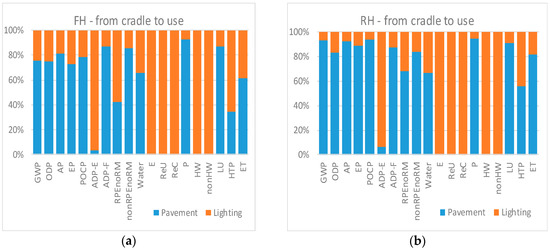
Figure 4.
Comparison of “from cradle to use” impacts of (a) FH and (b) RH.
The bar graphs in Figure 4 highlight that the allocation of impacts between pavement and lighting slightly depends on the pavement type. It is possible to observe that the pavement construction is responsible for the most contributions to air emissions (i.e., GWP, ODP, AP, EP, POCP: On average 91%) and consumption of fossil fuels (i.e., ADP-F) and non-renewable primary energy (i.e., nonRPEnoRM: On average 79%); on the other hand, lighting production and installation give the highest contributions to consumption of abiotic elements (i.e., ADP-E: On average 92%) and electricity (i.e., E: On average more than 98%).
The environmental effects of the expected traffic have been calculated considering Euro 5 stages of vehicles [42] because they represent the majority of the total Italian fleet [43]. Table 5 lists the obtained overall results, and the partial contributions from different expected vehicles according to Table 1.

Table 5.
Impact categories of traffic.
The results listed in Table 5 highlight that, on average, the traffic affects the environment more than the pavement and lighting system construction. Paying attention to the first seven calculated ICs, which are defined by EN 15804 (EN, 2013) as “environmental impacts”, the traffic has burdens two to 14 times more than the “from cradle to use” phase (Table 4). The lowest difference is for ADP-E (+119%), while the highest difference is for ODP (+1431%), ADP-F (+1311%), and GWP (+1284%). On average, the environmental impacts calculated in Table 4 account for 15% of those listed in Table 5.
Light vehicles (i.e., passenger cars and motor scooters) have overall burdens comparable to those of commercial and heavy vehicles: The average contribution of light vehicles to the traffic burden is 60%. P, ADP-E, and HTP are the worst ICs for light vehicles: Their average contribution to the total traffic burdens are 98%, 87%, and 76%, respectively.
Regarding the lighting system, the yearly switching on of the lighting requires the effective consumption of energy listed in Table 3. These values have been used to calculate the impacts from lighting switch on having regard to the Italian country mix available on SimaPro. The impacts from lighting switching on are listed in Table 6.

Table 6.
Overall impact categories of lighting switching on during the service life.
Figure 5a,b shows the contributions of traffic and lighting to the use phase impacts for FH and RH, respectively. The authors do not represent the results obtained for scenarios FL and RL because there are not graphically appreciable differences between cases which differ for lighting type.
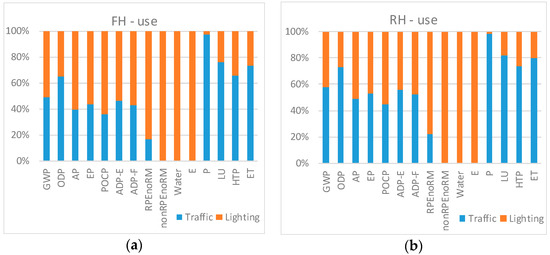
Figure 5.
Impacts of traffic and lighting to the use phase impacts. (a) FH scenario; (b) RH scenario.
From Figure 5, the allocation of impacts between traffic and lighting slightly depend on pavement type: Few percentage points distinguish the FH results from the RH ones. Moreover, great attention should be paid to the fact that traffic and lighting have comparable contributions to all the environmental impacts (i.e., GWP, ODP, AP, EP, POCP, ADP-E, and ADP-F), while traffic is crucial for particulates (it has the highest relative contribution: More than 97% of the overall P in the use phase), but it gives zero or quite low contribution to nonRPEnoRM, Water, and E. Regarding the additional ICs (i.e., LU, HTP, and ET), which have direct correlations with life quality, traffic causes, on average, more than 65% overall use burdens. This highlights the importance and need for appropriate and comprehensive LCA analyses.
Pavement and lighting system maintenance imply the IC values listed in Table 7 and Table 8, respectively.

Table 7.
Overall impact categories of pavement maintenance during the service life.

Table 8.
Overall impact categories of lighting system maintenance during the service life.
Results listed in Table 7 reflect data available in the literature [23]: Having the same service life and equivalent structural performances, a rigid pavement requires lower maintenance works than a flexible pavement. Therefore, this implies lower financial and environmental costs: In the study, ICs of rigid pavement are up to three orders of magnitude lower than those of flexible pavement.
Figure 6 shows the dominance analysis of the LCA referred to pavement and lighting maintenance. Unlike the use phase, the contributions of pavement and lighting maintenance to the assessed ICs depend on both the pavement and lighting type.
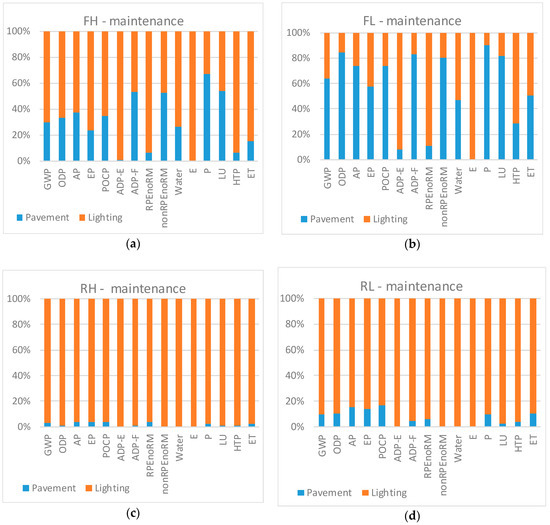
Figure 6.
Dominance analysis of the maintenance phase. (a) FH scenario; (b) FL scenario; (c) RH scenario; (d) RL scenario.
In Figure 6c,d it is possible to appreciate that maintenance burdens in scenarios with concrete pavements are, on average, related for more than 90% to lighting (i.e., 99% for RH and 94% for RL). Therefore, with respect to the corresponding scenarios with asphalt pavement, the impacts from pavement maintenance are negligible. On the other hand, when the tunnel is paved with asphalt (or low-reflective materials), maintenance of the pavement contributes, on average, to 72% of the overall maintenance impacts (Figure 6a,b). Particularly unfavourable for pavement maintenance is FL, when the higher burdens related to flexible pavement maintenance combine with lower burdens related to LED lamps maintenance.
Combining the results obtained for the examined “from cradle to end of life” phases, the overall IC values have been obtained. They are listed in Table 9. For each IC, bold characters evidence the lowest value.

Table 9.
Impact categories of the examined “from cradle to end of life” LCA.
For all examined impact categories, the greenest solution has concrete pavement and an LED lighting system (i.e., RL), while the worst scenario is FH. The use of concrete pavement and LED lamps ensures the best performances in terms of environmental burdens because this pair of options combines the most environmental-friendly examined solutions in terms of both road pavement and tunnel lighting technology. Moreover, the technological development in the field of LEDs is still ongoing: The increases of the specific luminous flux and luminous efficiency [18] will ensure results that are even more interesting. In Table 9, the highest differences between the examined scenarios were found for ReU (2.41 × 104 kg for FH and 1.82 × 103 kg for RL) and HW (4.91 × 101 kg for FH and 2.81 kg for RL). More than one order of magnitude varies between the obtained results, which affect by product and waste production and management. These results clearly confirm the need for analysing a process with an inclusive approach, without omitting processes or activity within the boundaries that define the system being studied.
Therefore, the radar graphs in Figure 7a–d represent the adimensional obtained results of each IC attributing 100 to the value of FH. According to [30], each graph compares impact categories, which are grouped by similarities regarding their effects on the environment: Environmental impacts (Figure 7a); water, electricity, and primary energy consumption (Figure 7b); solid and powdery output flows (Figure 7c); and life quality ICs (Figure 7d).
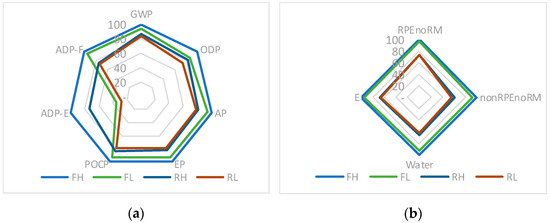

Figure 7.
Comparison of obtained results of (a) environmental impacts; (b) consumption; (c) output flows; (d) life quality ICs.
Figure 7a–d demonstrate that it is not possible to conduct correctly both synthetic and comprehensive environmental analyses because the results of each scenario vary with each other considering different ICs. Regarding the environmental impacts, GWP, ODP, AP, EP, POCP, and ADP-E have similar mutual trends, but ADP-E is seriously affected by the lighting technology (Figure 7a). On the other hand, consumptions depend on the pavement type more than the lighting technology (Figure 7b). Pavement type and much more lighting technology affect the output flows, but powder emissions are constant in the examined scenarios (Figure 7c). The results of life quality ICs are more stable (Figure 7d): The radar curves are regular, and their mutual percentage differences are, on average, less than those observed for environmental impacts, consumption, and output flows.
4. Discussion
Figure 8a–d show the dominance analysis of the LCA referred to construction (both pavement and lighting), maintenance (both pavement and lighting), and use (both traffic and lighting) phases. The acronyms, PC, LC, PM, and LM, refer to pavement construction, lighting construction, pavement maintenance, and lighting maintenance, respectively.
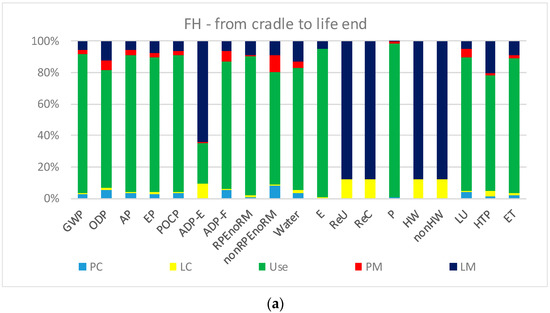
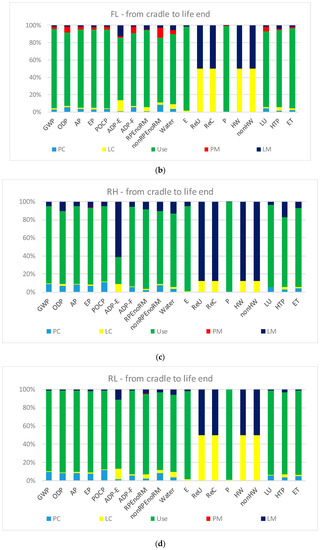
Figure 8.
Dominance analysis of the LCA. (a) FH scenario; (b) FL scenario; (c) RH scenario; (d) RL scenario.
For all impact categories except ReU, ReC, HW, and nonHW, the dominant phase is “Use”, the reason why the study started. Indeed, the “Use” phase does not affect ReU, ReC, HW, and nonHW: They only depend on lighting construction and maintenance activities. Their percentage allocation between construction and maintenance depends on the lighting type: For LED, the contributions are equally distributed, while for HPS lamps, the maintenance phase contributes to more than 80% of the overall results. Moreover, HPS lamps affect the more than 60% contribution of LM to ADP-E: This trend is observed for both FH and FL, and it strongly differs from RH and RL whose LM is on average 10%.
LU, HTP, and ET, which are the sustainability ICs calculated in addition to the categories listed in EN15804, are definitely due to “Use”, as chemical and powder emissions on air. Particularly, more than 97% of the impact category, P, is caused by the Use phase, and more specifically by the vehicular traffic. Tunnel lighting is responsible for 21%, 30%, and 23% of the overall LU, HTP, and ET calculated for the Use phase, respectively. Therefore, traffic gives the highest contributions to the “Use” phase: It highlights the need for tough legislation in this sector to ensure high environmental standards.
Lighting construction, maintenance, and use significantly contribute to the overall environmental categories: Their average percentage contributions range from 33% for ODP to 73% for ADP-E. This result highlights the need for sustainable and low-impacting methods of both electricity production and road vehicles.
The construction phase has the lowest burden results: Its average percentage contribution is less than 10%. Regarding the maintenance phase, the obtained trend of pavement maintenance is interesting. In Figure 8, its incidence is appreciable only in FH and FL (red elements), while in RH and RL, it is not. It confirms the most onerous (and impacting) activities needed for managing road asphalt pavements.
5. Conclusions
A correct design of lighting system in road tunnel could improve safety and comfort for drivers, and reduce energetic costs for road management bodies. Compared to standard solutions, high-reflective pavement materials and high-performance lamps can be particularly advantageous in road tunnels to obtain energy-saving effects. Different international institutions undertook technical, scientific, and legislative initiatives to improve efficiency of road tunnel lighting and reduce its environmental burdens.
This paper presents the LCA of four scenarios composed of LED or HPS lighting and flexible or concrete pavement in an Italian twin-tube road tunnel during its 20-year service life. This period is the conventional service life of flexible pavements, while rigid ones are expected to maintain their integrity and performances for a longer period. The environmental analysis has been carried out according to European standard, EN 15804, using the software package, ProLITE7.0, for lighting design and SimaPro 8.0.5.13 for LCA; all input data comply with Italian standards for road pavement and lighting design. The examined stages are: Road construction, lighting construction and installation, traffic, switching on of lamps, pavement maintenance, and lighting maintenance. Based on the results of this environmental investigation, the following conclusions are drawn:
- Regarding the pavement-related burdens, the construction impacts of flexible pavement are lower than those of rigid one; the opposite was found for the maintenance phase.
- Regarding the lighting-related burdens, the construction and installation of LED lamps imply more consequences than that of HPS lamps; the opposite was found for the maintenance phase.
- Regarding the traffic-related burdens, it implies the highest contributions to the “Use” phase, particularly it is responsible for more than 70% of the overall LU, HTP, and ET values. Moreover, it contributes to more than 99% of powder emissions.
- The use phase, which is composed of traffic and electricity consumption due to tunnel lighting, is the most impacting phase between the examined ones (i.e., construction and maintenance of both pavement and lighting).
- The “from cradle to end of life” highlights that the scenario with concrete pavement and LED lamps has the best environmentally results except for consumption of renewable and non-renewable primary energy, water, and electricity.
- GWP, which is the most commonly used parameter to evaluate the environmental impact of a process, has a stable trend between the examined scenarios (the worst performance is 14% higher than the best one), while important differences have been observed for other ICs. This justifies the comprehensive analysis carried out by the authors to boost informed choices for reducing the environmental impact related to tunnel lighting.
Finally, it is important to highlight that the importance of this case study is that it provides results obtained from hypotheses and input data related to Italian standards and procedures currently adopted in road tunnels. The comprehensive assessment of the environmental impact related to construction and maintenance of lighting and road pavement, and traffic provides data that could be used to critically approach this strategic sector whose impacts are economic, social, and environmental.
Author Contributions
Conceptualization, L.M.; Formal analysis, L.M.; Methodology, G.C.; Software, L.M.; Validation, G.C. and P.D.M.; Writing—original draft, G.C., P.D.M. and L.M.; Writing—review & editing, G.C., P.D.M. and L.M.
Funding
This research received no external funding.
Acknowledgments
The authors thank AITEC—Technical and Economical Association of Italian cement producers—for concession of the software package SimaPro.
Conflicts of Interest
The authors declare no conflict of interest.
References
- Neves, D.; Baptista, P.; Simões, M.; Silva, C.A.; Figueira, J.R. Designing a municipal sustainable energy strategy using multi-criteria decision analysis. J. Clean. Prod. 2018, 176, 251–260. [Google Scholar] [CrossRef]
- Rabazan, O.; Peña-García, A.; Pérez-Ocón, F.; Gómez-Lorente, D. A simple method for designing efficient public lighting, based on new parameter relationships. Expert Syst. Appl. 2013, 40, 7305–7315. [Google Scholar] [CrossRef]
- Löfsjögård, M.; Silfwerbrand, J. Proposal for Improvement of Road Lighting Design for Concrete Roads. Road Mater. Pavement Des. 2004, 52, 193–213. [Google Scholar] [CrossRef]
- Municipality of Abu Dhabi City. Abu Dhabi Sustainable Public Lighting Strategy. In Proceedings of the Policy and Implementation—Infrastructure Arabia Summit 2012. Available online: http://docplayer.net/21290213-Abu-dhabi-sustainable-public-lighting-strategy-policy-implementation-infrastructure-arabia-summit-2012.html (accessed on 11 November 2018).
- Schild, P. Horizon 2020: Calls—Overview, The EU Framework Programme for Research and Innovation, 2014. SDU. Available online: https://www.sdu.dk/-/media/files/forskning/forskningsstoette/aktuelt/horizon+2020+2014+qa.pdf (accessed on 9 November 2018).
- Wayman, M.; Peeling, J.; Mocanu, I.; Nitsche, P.; Rands, J. Call 2013 Energy Efficiency REETS, 2015, Catalogue of Energy Reducing Options (CEDR). Available online: http://www.cedr.eu/strategic-plan-tasks/research/cedr-call-2013/call-2013-energy-efficiency/ (accessed on 9 November 2018).
- Maheswari, C.; Jeyanthi, R.; Krishnamurthy, K.; Sivakumar, M. Implementation of Energy Management Structure for Street Lighting Systems. Mod. Appl. Sci. 2009, 36, 31–37. [Google Scholar] [CrossRef]
- Peña-García, A.; López, J.C.; Grindlay, A.L. Decrease of energy demands of lighting installations in road tunnels based in the forestation of portal surroundings with climbing plants. Tunn. Undergr. Space Technol. 2015, 46, 111–115. [Google Scholar] [CrossRef]
- Sunky, Z.; Mohit, P. Lighting design of an urbanized tunnel. Present at the Seminar Series 2012 Part 4 Research Projects, The University of Auckland, Auckland, New Zealand, 6–7 September 2012. [Google Scholar]
- Peeling, J.; Wayman, M.; Mocanu, I.; Nitsche, P.; Rands, J.; Potter, J. Energy efficient tunnel solutions. In Proceedings of the 6th Transport Research Arena, Warsaw, Poland, 18–21 April 2016. [Google Scholar]
- Jiang, Y.; Li, S.; Guan, B.; Zhao, G. Cost effectiveness of new roadway lighting systems. J. Traffic Transp. Eng. 2015, 23, 158–166. [Google Scholar] [CrossRef]
- REETS. REETS: Realistic Energy Efficient Tunnel Solutions-Initial review of Technologies, 2015. Catalogue of Energy Reducing Options (CEDR). Available online: http://www.cedr.eu/download/other_public_files/research_programme/call_2013/energy_efficiency/reets/D1.1-catalogue_of_energy_reducing_options_v1_0.pdf (accessed on 9 November 2018).
- Miccoli, S.; Finucci, F.; Murro, R. Assessing Project Quality: A Multidimensional Approach. Adv. Mater. Res. 2014, 1032, 2519–2522. [Google Scholar] [CrossRef]
- Miccoli, S.; Finucci, F.; Murro, R. Measuring Shared Social Appreciation of Community Goods: An Experiment for the East Elevated Expressway of Rome. Sustainability 2015, 711, 15194–15218. [Google Scholar] [CrossRef]
- Peña-García, A. The impact of lighting on drivers well-being and safety in very long underground roads: New challenges for new infrastructures. Tunn. Undergr. Space Technol. 2018, 80, 38–43. [Google Scholar] [CrossRef]
- Moretti, L.; Cantisani, G.; Di Mascio, P. Management of road tunnels: Construction, maintenance and lighting costs. Tunn. Undergr. Space Technol. 2016, 51, 84–89. [Google Scholar] [CrossRef]
- Krsipel, S.; Maier, G.; Peyerl, M. The Influence of Concrete Roads on Safety and Energy Saving in Tunnels. Adv. Civ. Eng. Technol. 2018, 1, 000510. [Google Scholar] [CrossRef]
- Salata, F.; Golasi, I.; Bovenzi, S.; de Lieto Vollaro, E.; Pagliaro, F.; Cellucci, L.; Coppi, M.; Gugliermetti, F.; De Lieto Vollaro, A. Energy Optimization of Road Tunnel Lighting Systems. Sustainability 2015, 7, 9664–9680. [Google Scholar] [CrossRef]
- Moretti, L.; Cantisani, G.; Di Mascio, P.; Caro, S. Technical and economic evaluation of lighting and pavement in Italian road tunnels. Tunn. Undergr. Space Technol. 2017, 65, 42–52. [Google Scholar] [CrossRef]
- Moretti, L. Technical and economic sustainability of concrete pavements. Mod. Appl. Sci. 2014, 83, 1–9. [Google Scholar] [CrossRef]
- Jung, Y.; Freenman, T.J.; Zollinger, D.G. Guidelines for Routine Maintenance of Concrete Pavement; FHWA/TX-08/0-5821-1; Federal Highway Administration: Austin, TX, USA, 2008. [Google Scholar]
- Bartolomé, C. The Role of Concrete Pavement in Tunnel Safety, 2015. Smart Transportation Alliance. Available online: http://smart-transportation.org/wp-content/uploads/2015/01/STA_DP_2_2015_Def.pdf (accessed on 9 November 2018).
- Di Mascio, P.; Moretti, L. Concrete vs. asphalt: Pavement and lighting costs in Italian road tunnels. In ACI Special Publication SP-326 Durability and Sustainability of Concrete Structures, Proceedings of the 2nd Workshop on Durability and Sustainability of Concrete Structures, Moscow, Russia, 6–7 June 2018; American Concrete Institute: Michigan, MI, USA, 2018; in press. [Google Scholar]
- Franz, M.; Wenzl, F.P. Critical review on life cycle inventories and environmental assessments of led-lamps. Crit. Rev. Environ. Sci. Technol. 2017, 4721, 2017–2078. [Google Scholar] [CrossRef]
- Annual Report 2006: Refurbishment Works for Road TUNNELS carried on during Year 2012 and Forecast for Year 2013; Consiglio Superiore dei Lavori Pubblici: Rome, Italy, 2013.
- Consiglio Nazionale delle ricerche (CNR). Catalogo Italiano delle Pavimentazioni Stradali; BU 178/1995; CNR: Rome, Italy, 1995. (In Italian) [Google Scholar]
- Ente Nazionale Italiano di Normazione (UNI). UNI 10439:2001: Illuminotecnica—Requisiti Illuminotecnici delle Strade Con Traffico Motorizzato; UNI: Milan, Italy, 2001. (In Italian) [Google Scholar]
- Ente Nazionale Italiano di Normazione (UNI). UNI EN 13201-2:2004: Illuminazione Stradale—Parte 2: Requisiti Prestazionali; UNI: Milan, Italy, 2004. (In Italian) [Google Scholar]
- Ente Nazionale Italiano di Normazione (UNI). UNI 11095:2011: Illuminazione delle Gallerie Stradali; UNI: Milan, Italy, 2011. (In Italian) [Google Scholar]
- European Committee for Standardization (EN). Sustainability of Construction Works—Environmental Product Declarations—Core Rules for the Product Category of Construction Products; EN 15804:2012+A1:2013; European Committee for Standardization: Brussels, Belgium, 2013. [Google Scholar]
- SimaPro 8.0.5.13; Software SimaPro. Pré; Consultants: Amersfoort, The Netherlands, 2016.
- Guinée, J.B.; Gorrée, M.; Heijungs, R.; Huppes, G.; Kleijn, R.; van Oers, L.; Wegener Sleeswijk, A.; Suh, S.; Udo de Haes, H.A.; de Bruijn, H.; et al. Life Cycle Assessment: An Operational Guide to the ISO Standards; Kluwer Academic Publishers: Dordrecht, The Netherlands, 2002. [Google Scholar]
- Parlamento Italiano. Nuovo Codice della Strada. Decreto Legislativo 30 aprile 1992, n.285; Parlamento Italiano: Rome, Italy, 1992. [Google Scholar]
- Prolite 7.0, version 7.0; Manuale Prolite; Gewiss: Cenate Sotto, Italy, 2016.
- Moretti, L.; Mandrone, V.; D’Andrea, A.; Caro, S. Evaluation of the environmental and human health impact of road construction activities. J. Clean. Prod. 2018, 172, 1004–1013. [Google Scholar] [CrossRef]
- Moretti, L.; Mandrone, V.; D’Andrea, A.; Caro, S. Comparative “from cradle to gate” Life Cycle Assessments of Hot Mix Asphalt (HMA) Materials. Sustainability 2017, 93, 400. [Google Scholar] [CrossRef]
- Moretti, L.; Caro, S. Critical analysis of the life cycle assessment of the Italian cement industry. J. Clean. Prod. 2017, 152, 198–210. [Google Scholar] [CrossRef]
- Tahkamo, L.; Halonen, L. Life cycle assessmnt of road lighting luminaires-Comparison of light-emitting diode and high-pressure sodium technologies. J. Clean. Prod. 2015, 93, 234–243. [Google Scholar] [CrossRef]
- Moretti, L.; Di Mascio, P.; Bellagamba, S. Environmental, human health and socio-economic effects of cement powders: The multicriteria analysis as decisional methodology. Int. J. Environ. Res. Public Health 2017, 146, 645. [Google Scholar] [CrossRef] [PubMed]
- EUPAVE. A Guide on the Basic Principles of Life-Cycle Cost Analysis (LCCA) of Pavements; European Concrete Paving Association (EUPAVE): Brussels, Belgium, 2018. [Google Scholar]
- Institut Bauen und Umwelt. Product Category Rules for Construction Products from the Range of Environmental Product Declarations of Institut Bauen und Umwelt e.V. (IBU), Part B Requirements on the EPD for Luminaires, Lamps and Components for Luminaires; Institut Bauen und Umwelt: Berlin, Germany, 2013. [Google Scholar]
- European Parliament and of the Council. Regulation (EC) No 715/2007 of the European Parliament and of the Council of 20 June 2007 on Type Approval of Motor Vehicles with Respect to Emissions from Light Passenger and Commercial Vehicles (Euro 5 And Euro 6) and on Access to Vehicle Repair and Maintenance Information; European Parliament and of the Council: Brussels, Belgium, 2007. [Google Scholar]
- ACI. Italian Vehicle Fleet. Available online: http://www.opv.aci.it/WEBDMCircolante/ (accessed on 12 September 2018).
© 2018 by the authors. Licensee MDPI, Basel, Switzerland. This article is an open access article distributed under the terms and conditions of the Creative Commons Attribution (CC BY) license (http://creativecommons.org/licenses/by/4.0/).